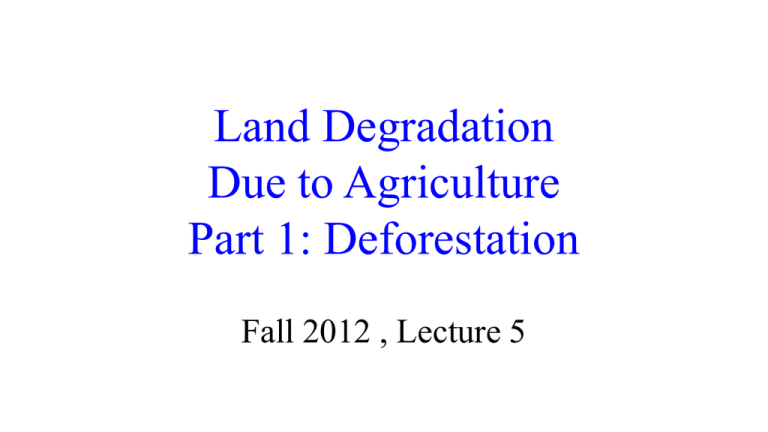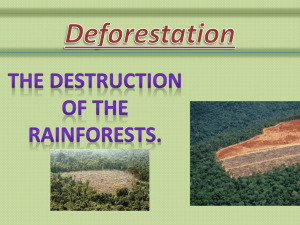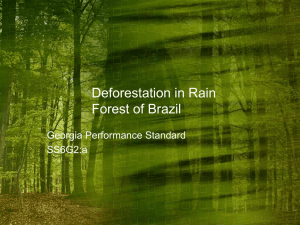Land Degradation Due to Agriculture - FAU
advertisement

Land Degradation Due to Agriculture Part 1: Deforestation Fall 2012 , Lecture 5 Land Degradation Processes • Agriculture contributes to land degradation in two major ways Deforestation Tilling the soil 2 The Dust Bowl • Intro to Ken Burns “The Dust Bowl” on PBS 3 “A Hundred Dead Cities” • Walter Lowdermilk describes a region in Syria where invasion by a Persian Army and later desert nomads during the seventh century, had turned a thriving region to wasteland • Soil and water conservation practices used for centuries were abandoned • Ancient buildings were still standing in stark isolated relief, but they were on bare rock • The soil was gone 4 Lowdermilk’s Work • Lowdermilk, former Assistant Chief of Soil Conservation Service of the U.S. Department of Agriculture (USDA), traveled abroad for 18 months in 1938-39 to look at lands that had been cultivated for thousands of years, seeking to learn how these older civilizations had coped with soil erosion • He found that some had managed their land well, maintaining its fertility over long stretches of history, and were thriving • Jared Diamond, in his book Collapse, tells similar stories in many civilizations 5 History Repeats Itself • This story is being repeated in many places today • Lester Brown, in Plan B 3.0, mentions Lesotho and Syria • Similar problems are occurring in Haiti, the Philippines, the Sahel region of Africa, Thailand, and other regions 6 Government Restrains • In 1989, Thailand announced a nationwide ban on tree cutting following severe flooding and the heavy loss of life in landslides • In August 1998, after weeks of record flooding in the Yangtze River basin and a staggering $30 billion worth of damage, the Chinese government banned all tree cutting in the upper reaches of the basin • In December 2004, Philippine President Gloria Macapagal Arroyo “ordered the military and police to crack down on illegal logging, after flash floods and landslides, triggered by rampant deforestation, killed nearly 340 people” 7 Deforestation Scale • At the beginning of the 20th century, the earth’s forested area was estimated at 5 billion hectares • Since then it has shrunk to just under 4 billion hectares, with the remaining forests rather evenly divided between tropical and subtropical forests in developing countries and temperate/boreal forests in industrial countries 8 Forest Losses and Gains • Developing world has lost some 13 million hectares of forest a year since 1990 • Industrial world has gained an estimated 5.6 million hectares of forest land each year, principally from abandoned cropland returning to forests on its own and from the spread of commercial forestry plantations • Net change is a loss of 7 million hectares/year 9 Forest Quality • The 4 billion hectares remaining is not all high quality forest • World Resources Institute says that only 40 percent of the world’s remaining forest cover can be classified as frontier forest • WRI says “the vast majority (of remaining forests) are no more than small or highly disturbed pieces of the fully functioning ecosystems they once were.” 10 Frontier Forest • Frontier forest is defined as “large, intact, natural forest systems relatively undisturbed and big enough to maintain all of their biodiversity, including viable populations of the wide-ranging species associated with each type” 11 Use of Wood • In 2011, 1.88 billion cubic meters of wood were used for fuel worldwide • This amounted to about 47% of all the wood consumed worldwide in 2011 12 Wood Use in Developing Countries • In Haiti, about 89% of the wood produced is used for fuel in 2011 • Lester Brown said developing countries use about 75% of their wood for fuel 13 Urban Firewood Demand • As urban firewood demand surpasses the sustainable yield of nearby forests, the woods slowly retreat from the city in an ever larger circle, a process clearly visible from satellite photographs taken over time. • As the circles enlarge, the transport costs of firewood increase, triggering the development of an industry for charcoal, a more concentrated form of energy 14 Deforestation in Bolivia • Images from Bolivia, 1975 through 2000, Satellite Imagine Corporation 15 Papua New Guinea (PNG) • PNG is losing 362,400 hectares of rainforest every year, equivalent to 1.4 per cent of its forested land area • Scientists predict that, in 12 years, more than 80 percent of the island’s accessible forests, which represents more than half of all the remaining rainforests in Papua New Guinea, will either be completely cleared or badly degraded and fragmented 1990 2005 16 Amazon Deforestation in Rondonia, Brazil, 2000-2010 • The state of Rondonia in western Brazil is observed by the Moderate Resolution Imaging Spectroradiometer (MODIS) on NASA's Terra satellite • This timelapse on the next slide shows the reduction of the forest from 2000-2010 17 Amazon Deforestation 18 Amazon Deforestation Pattern • Deforestation follows a fairly predictable pattern in these images • The first clearings that appear in the forest are in a fishbone pattern, arrayed along the edges of roads • Over time, the fishbones collapse into a mixture of forest remnants, cleared areas, and settlements • This pattern follows one of the most common deforestation trajectories in the Amazon 19 Sequence of Deforestation • Legal and illegal roads penetrate a remote part of the forest, and small farmers migrate to the area • They claim land along the road and clear some of it for crops • Within a few years, heavy rains and erosion deplete the soil, and crop yields fall • Farmers then convert the degraded land to cattle pasture, and clear more forest for crops • Eventually the small land holders, having cleared much of their land, sell it or abandon it to large cattle holders, who consolidate the plots into large areas of pasture 20 Incoming Radiation • Some trace gases are known as “greenhouse" gases because they function like the glass in a greenhouse Incoming radiation strikes the earth and some is absorbed This heats the earth and the earth reradiates in the infrared portion of the spectrum 21 Infrared Blanket • If the earth's atmosphere were transparent to infrared radiation, the earth would lose heat rapidly and would have a low average temperature • This temperature would be about 254 K • Although life might survive at these temperatures, it would be difficult and life on earth would likely be much different from life as we know it • Fortunately, some gases in the earth's atmosphere absorb some outgoing infrared radiation 22 Greenhouse Gas Properties • Greenhouse gases absorb infrared radiation that corresponds to the vibrational and rotational energy levels of their bonds • Normally these gases have three or more atoms 23 Major Atmospheric Gases • The major gases in the atmosphere, nitrogen, oxygen, and argon, are either mono- or diatomic • They do not have any appreciable absorption in the infrared 24 Polyatomic Gases • The most abundant polyatomic gas is water • Water is the most important greenhouse gas in the sense that it accounts for the major portion of the natural greenhouse effect • Water is followed by carbon dioxide and methane 25 Absorption of IR • IR radiation absorbed by polyatomic molecules excites rotational and vibrational states and raises the molecules to a higher energy state • They return to the ground state by radiating IR radiation in all directions • IR stands for infrared, light with a wavelength longer than red light 26 An IR Blanket • Some of this radiation is directed at the ground and will likely be reabsorbed by the ground • Other rays are directed sideways, or upward • These rays will likely encounter other greenhouse gas molecules before escaping from the atmosphere 27 Absorption • Each gas adsorbs at a discrete set of wavelengths • Combinations of gases are more effective at absorbing across the electromagnetic spectrum than any single gas • Some gases are much more effective than others 28 Natural Greenhouse Effect • The atmosphere naturally contains carbon dioxide, methane and nitrous oxide • These gases--together with water vapor--create the natural greenhouse effect • They trap some of the sun's energy and keep the Earth warm enough to sustain life 29 Carbon Dioxide • Each year we add more than 30 billion tons of carbon dioxide to the air mainly by: Burning fossil fuels Cutting down and burning trees • Deforestation accounts for about 17 percent of the carbon dioxide increase from human activities 30 Global Carbon Flux 31 Effect of Greenhouse Gases • Chart shows how much warming could be caused by each of the gases that human activities release 32 A Global Problem • An increase in global temperature would bring changes to the entire planet, and therefore to every nation • This makes it an international issue which needs worldwide study and responses • Individual countries are each responsible for their own greenhouse gas production 33 Deforestation • Until 50 years ago most of the carbon dioxide from deforestation was released from boreal and temperate zones • Now tropical deforestation is the largest source • Efforts to curb deforestation are seen as a lowcost option for emissions reduction 34 Tropical Deforestation • Tropical deforestation is especially important because it releases large amounts of CO2, because of the carbon stored in the vegetation and released when tropical forests are cut down 35 Causes of Tropical Deforestation • Commercial logging • Large-scale agriculture (e.g., cattle ranching, soybean production, oil palm plantations) • Small-scale permanent or shifting (slash-andburn) agriculture • Fuelwood removal 36 Images from Google Earth 37 Exacerbation of Deforestation • These causes combine to exacerbate deforestation Commercial logging often includes road construction, which in turn opens the forest for subsistence farmers At times, tropical deforestation results from weak land tenure and/or weak or corrupt governance to protect the forests 38 REDD • Programs called REDD are being considered by Congress • REDD stands for Reducing Deforestation and Forest Degradation • The primary goal is to reduce carbon emissions 39 Secondary Benefits • Preserving biological diversity • Sustaining livelihoods for the rural poor and for indigenous communities and culture 40 Implementing REDD • In the fight against climate change, billions of dollars have been pledged to save the world's forests • A scheme called Reducing Emissions from Deforestation and Forest Degradation - or REDD+ - is being championed as a possible solution. • In the Amazon, a team of six researchers linked to the Center for International Forestry Researchers have been trying to understand what lessons can be learned from a project called Bolsa Floresta, which compensates families to safeguard the forests. 41 Bolsa Floresta Project 42 Forests Effects on Carbon Dioxide • Forests are carbon sinks in their natural state They store more carbon than they release • Trees absorb CO2 and convert carbon into leaves, stems, and roots, while releasing oxygen • Forests account for more than a quarter of the land area of the earth, and store more than three-quarters of the carbon in terrestrial plants and nearly 40% of soil carbon 43 Carbon Dioxide Release • Forests clearing releases some of their carbon to the atmosphere Slowly through decay Quickly through burning • One estimate shows that land use change, primarily deforestation, releases about 5.9 Gt CO2 (gigatons or billion metric tons of CO2) annually, about 17% of all annual anthropogenic GHG emissions 44 Carbon Storage • Forests store enormous quantities of carbon, and contain more biomass per hectare in vegetation than other biomes • Carbon sequestration and release vary by forest type, although generalizations can be made about the three major forest biomes— boreal, temperate, and tropical forests 45 Average C Levels Vegetation & Soils • Table 1 shows global average carbon levels in the vegetation and soils for major terrestrial biomes, including the forest biomes • Quantities shown in Table 1 should be recognized as global averages, with substantial variation of carbon stocks within each biome; Wetlands can be dominated by trees (a swamp) or by grasses (a marsh) Tropical forests can be very wet (rainforests) or quite dry (trees in a savannah) 46 47 Another GHG • There has also been some discussion of the relationship between forests and methane (CH4), a less prominent but far more potent GHG than CO2 • On a per molecule basis, methane is at least 21 times as effective at trapping infrared radiation as carbon dioxide 48 Future Research • Evidence of the relationship between deforestation and CH4 release is still limited • It generally shows forests to be net CH4 sinks, except in water-saturated soils (i.e., forested wetlands) • It is unclear whether activities that modify forest cover (e.g., deforestation) affect CH4 absorption and release 49 Ongoing Research • Kew, The Royal Botanic Gardens, was founded in 1759, and declared a UNESCO World Heritage Site in 2003 • Alongside Kew Gardens in London, Kew has a second country garden based at Wakehurst which is the home of Kew’s Millennium Seed Bank. • Kew is a world leader in plant science and conservation. Our work helps to discover and describe the world’s plant and fungal diversity, safeguard the world's plant life for our future, promote the sustainable use of plants and inspire an appreciation of plants and the environment 50 Kew Views on Climate Change 51







